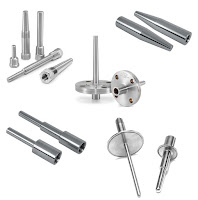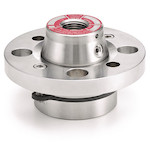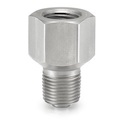 |
| Thermowells come in a wide variety of shapes, materials, and sizes. (Courtesy of Ashcroft) |
Thermowells are critically important for installations where the temperature element (RTD, thermocouple, etc.) must be replaceable without de-pressurizing the process.
Thermowells may be made out of any material that is thermally conductive, pressure-tight, and not chemically reactive with the process. Most thermowells are formed out of either metal (stainless steel or other alloy) or ceramic materials.
A simple diagram showing a thermowell in use with a temperature sensor (RTD) is shown here:
 |
| Typical RTD thermowell installation. |
As useful as thermowells are, they are not without their caveats. All thermowells, no matter how well they may be installed, increase the first-order time lag of the temperature sensor by virtue of their mass and specific heat value. It should be intuitively obvious that a few pounds of metal will not heat up and cool down as fast as a few ounces’ worth of RTD or thermocouple, and therefore the addition of a thermowell to the sensing element will decrease the responsiveness of any temperature- sensing element. What is not so obvious is that such time lags, if severe enough, may compromise the stability of feedback control. A control system receiving a “delayed” temperature measurement will not see the live temperature of the process in real time due to this lag.
For more information on thermowells, contact Mead O'Brien by visiting https://meadobrien.com or by calling (800) 892-2769.



